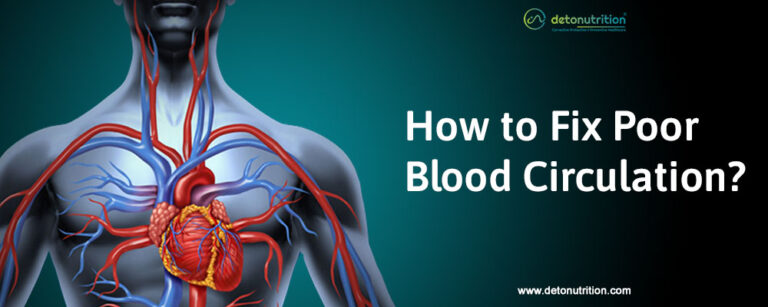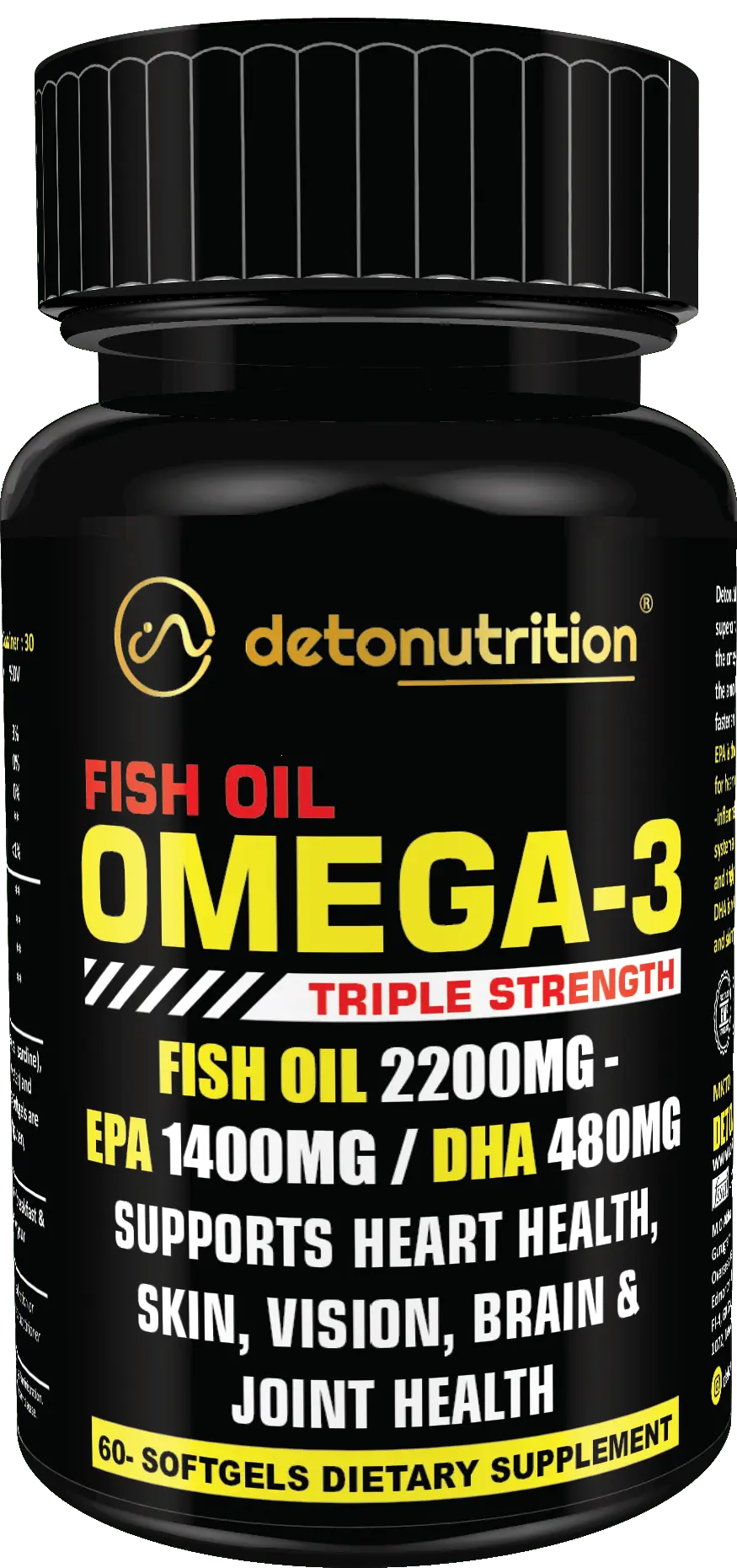How To Fix Poor Blood Circulation?
I’m sure that you may not think about poor blood circulation as much as you do exercising, eating healthy, and getting enough sleep, however, maintaining your blood circulation is one of the most important factors to keep you healthy and more active. Blood circulation is the process in which your heart pumps blood around the body. This whole process helps to deliver vital oxygen and nutrients to all your body organs and muscles. Good blood circulation in the body is crucial for your optimal health. And if you have poor blood circulation and you are finding a way to fix it then, you are at the right place. Read on to know the causes, symptoms, and prevention or treatment of poor blood circulation.
Read This Article - Best Omega 3 Fish Oil Supplement In 2023 Benefits, Uses, Precautions
What Can Cause Poor Blood Circulation?

1. Obesity
Obesity or being overweight is one of the leading risk factors which cause poor blood circulation. This is due to the additional pressure of extra weight on your veins which hinders the veins’ ability to circulate the blood back to the heart. Being obese also puts health at a big risk of getting other serious problems. It is important to lose some extra pounds to lower the risk of poor blood circulation as well as improve your overall health.
2. Diabetes
Many of you may think that diabetes only affects blood sugar levels but unfortunately, it also causes poor blood circulation. If diabetes is left untreated, it might reduce the sensation of your hands and feet while making them numb. It can also lead to certain problems which are associated with poor circulation such as muscle cramps, high blood pressure, atherosclerosis, and heart & veins problems.
3. Varicose veins
The varicose veins are often found on the backside of the leg area. Varicose veins are also referred as spider veins. In this condition, veins appear enlarged, engorged, and gnarled caused by valve veins. These veins can’t move blood efficiently as other healthy veins can, which may lead to poor circulation of blood. It is rare but sometimes varicose veins may also cause blood clots due to poor circulation of blood if left untreated.
4. Blood clots
A blood clot is also referred as a thrombus that can partially or entirely block or reduce the flow of blood. This can happen in any part of your body however, it usually develops in the legs and arms. Blood clots can be dangerous depending on the size and location of the deep vein blood clot. If a blood clot is left untreated, it may lead to stroke or even death.
5. Peripheral artery disease
Peripheral artery disease (PAD) is often happen in the legs and can lead to poor blood circulation. This disease is a circulation condition that causes pain, numbness, and tingling in your feet, hips, calves, and thighs due to narrow blood vessels and hard arteries. You may feel these symptoms while doing exercise, walking, or climbing. And these symptoms are relieved by doing some rest. Over time, poor blood circulation and PAD can lead to stroke and heart attack.
Read This Article - Get Rid Of TOP 8 MEN'S HEALTH CONCERNS AND SYMPTOMS ONCE AND FOR All
Symptoms of Poor Circulation
The most common symptoms of having poor blood circulation include:
- tingling
- numbness
- Strange pain in your limbs
- Pain in the whole body
- muscle cramps
- warmth or coolness
- Lack of concentration or energy
- Feeling cold (cold extremities in hands and feet)
- slow healing and weak immune system
- Feeling restlessness
- Thinning of hair or hair loss
- In men, erectile dysfunction
- Swelling in legs
- Itching
- Always feel tired
- Throbbing or stinging pain arms and legs
Read This Article - 9 Effective Ways To Improve Your Heart Health
How do you Fix Poor Blood Circulation?

If your question is “can poor blood circulation be fixed?” the answer is
Yes, you can fix poor blood circulation by performing the following
points that include:
1. Physical Activity
Start doing physical activities such as daily stretching, exercises, or
yoga to increase blood circulation. By doing aerobic or cardio exercises
you get your blood moving as well as your heart rate up. Doing any
physical activity is one of the best ways to improve your blood
circulation.
Even by doing a simple walk, you can make a big difference in your
overall health.
It is recommended to do moderate exercise for at least 30 minutes a day
to encourage healthy blood flow.
Here are some tips that help to incorporate exercise into your daily routines
- Always take an after dinner walk with your loved ones.
- Start or join a walking club or bike, running, or swimming club
- Schedule exercise time before attending your important work meeting, as doing exercise will make you more active.
2. Quit Alcohol and Smoking
Smoking causes plaque by damaging the walls of your arteries. As arteries harden, it becomes more difficult to circulate blood properly. The same thing goes to alcohol consumption. Consumption of alcohol also leads to arteries hardening, which later hinders the ability to circulate blood properly.
3. Wear compression socks
Wear compression socks or stockings to encourage the blood to flow effectively from your legs back up to your heart. Compression socks are best for those who are suffered from chronic venous insufficiency or varicose vein disease. It is suggested to wear compression socks during exercise, long car rides, and flights, and when you standing all day. Compression stockings also help to reduce the risk of blood clots and swelling.
4. Healthy Diet
Eating a healthy diet full of fruits, fatty fish and vegetables are also essential to improve blood circulation and your overall health. By eating a healthy diet, you can lower your cholesterol and blood pressure level. Foods that are rich in omega-3 fatty acids, iron, and nitric oxides are best to fix poor blood circulation. This includes spinach, kale, beetroot, cauliflower, carrots, watermelon, broccoli, citrus fruits, pomegranates, flax seeds, pumpkin seeds, walnuts, cod liver oil, salmon, tuna, lake trout, and sardines. Don’t forget to take multivitamin supplements for complete nutrition.
5. Elevate Your Legs
Elevating your legs above your heart for at least 15- 20 minutes a day can improve your blood circulation and reduce swelling in the legs. This is also the best way to decrease stress, relax or meditate. Elevating your legs can help to get relief from swelling, cramping, pain, fatigue, itching, and restlessness in your legs.
6. Manage Blood Pressure
High blood pressure can damage your heart and arteries by creating tiny tears in artery walls. By cutting back your sodium intake you can manage your blood pressure. Also, control your sugar level by limiting the consumption of sugary products. You can include legumes, leafy greens, whole grains, and proteins in your diet to lower your sugar level and manage blood pressure.
7. Stay hydrated
Staying hydrated is one of the most important things for your overall body. The benefits of drinking water are beyond thirst. It helps to carry nutrients and oxygen to your cells, flushes out bad bacteria, aid in digestion, and prevents constipation. It normalizes blood pressure by stabilizing the heartbeat, regulates body temperature by maintaining electrolyte balance, and promotes healthy blood circulation.
Few Tips to increase your fluid intake
- Focus on drinking other fluids such as milk, broth, fruit juice.
- Always carry your water bottle
- Drink green tea as it contains catechin that helps to improve the functionality of blood vessels.
- Add some non-alcoholic flavors to your water. You can also add fruit, herbs, or other sugar-free naturally-derived flavor drops to increase your water intake.
There are a lot of other things you can do to improve circulation. However, all you can do first is start making changes in your lifestyle that will improve your blood circulation.
Best foods to fix blood circulation and increase blood flow

- Garlic & Ginger
- Turmeric & Capsaicin
- Nuts and walnuts
- All types of citrus fruits and berries
- Fatty fish
- Beetroot & onion
Bad foods that can cause poor blood circulation
- Unsaturated fatty foods
- Processed food and red meat
- Foods containing more salt or sugar and trans fats
What is the best supplement for poor circulation?
Deto restore kit is the best supplement kit for poor circulation. It contains Myristica Fragrans, Piper Longum, and Saffron that help in improve blood circulation and have a natural source of iron. Deto restore kit is an herbal supplement kit that has no side effects and is best suited for all types. It helps to maintain your optimal health by cleansing your liver and kidney. It restores your complete body system to make it work best.
Frequently Asked Questions
1. Can bad blood circulation be fixed?
Ans: Yes, you can fix bad blood circulation. Follows are some tips to improve bad blood circulation.
- Walk for at least 20 minutes
- Wear Compression Stockings
- Stop Smoking
- Drink green or black tea
- Manage your stress.
- Take a cold shower.
- Quit alcohol
- Eat a healthy diet.
2. How can I increase blood flow naturally?
Ans: You can increase your blood flow naturally by including iron and omega 3 rich foods in your diet. This includes watermelon, broccoli, spinach, kale, beetroot, cauliflower, carrots, citrus fruits, pomegranates, walnuts, flax seeds, pumpkin seeds, cod liver oil, salmon, tuna, lake trout, and sardines.
3. What drinks help to fix poor blood circulation?
Ans: Following drinks help to fix blood circulation:
1. Beetroot juice
2. Pomegranate juice
3. Orange Juice
4. Fresh fruit and vegetable Smoothies
5. Water.
6. Green tea
7. Black tea
4. How do you check your circulation?
Ans: Certain factors help you to check your circulation.
These are the signs of normal circulation:
- Color: Pink
- Swelling: None
- Sensation: Yes
- Numbness or Tingling: No
- Temperature: Warm
- Motion: Yes (move the fingers and toes)
These are the signs of bad circulation:
- Color: pale or bluish (compare the color of both hands and feet if it turns pale or bluish color then not normal)
- Swelling: yes (swelling associated with significant pain)
- Sensation: no
- Temperature: cool ( If fingers or toes are cold, put a blanket on to cover the fingers or toes and check again in one hour if it is still cold then it’s not normal )
- Numbness or Tingling: yes (ask somebody to touch your feet if you feel nothing use a needle pin and if it still not working then your blood circulation is not normal)
- Motion: no (move the fingers and toes, if there is no movement then it’s not normal )
Poor blood circulation can develop several serious health conditions including pain, amputations, blood clots, non-healing wounds, and strokes. That’s why it is crucial to take care of yourself by eating healthy and doing physical exercise.

We have a vision to take good care of your health and nutrition with products which are made from research and experience. Our team is technical as well as experienced so that we can deliver you the best products for your health and wellness.
Stay Fit, Stay Healthy And Stay Happy Always!
QUICK LINKS
CATEGORIES
Subscribe Us
Subscribe to Dr. Aaditya's Health Blog Email Newsletter
© Copyright - Detonutrition. All Right Reserved 2025.




